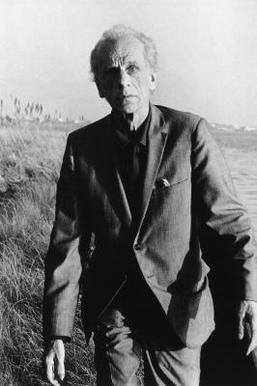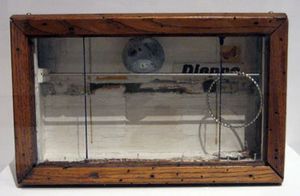Joseph Cornell facts for kids
Quick facts for kids
Joseph Cornell
|
|
|---|---|

Cornell in 1971
|
|
| Born | December 24, 1903 Nyack, New York, US
|
| Died | December 29, 1972 (aged 69) New York City, US
|
| Education | Self-taught |
| Known for | Assemblage, experimental film, sculpture |
Joseph Cornell (born December 24, 1903 – died December 29, 1972) was an American artist and filmmaker. He was a pioneer in a type of art called assemblage. This means he created art by putting together different found objects. He was also an experimental filmmaker, making unique movies. Joseph Cornell taught himself how to create art. He developed his own special style by using old, discarded items. He spent most of his life at home, caring for his mother and his brother who had a disability. Even so, he stayed in touch with other artists of his time.
Contents
About Joseph Cornell's Life
Joseph Cornell was born in Nyack, New York. His father worked in the textile industry, and his mother was a trained nursery teacher. Both of his parents came from well-known families in New York.
When Joseph's father passed away in 1917, his family faced difficult financial times. They moved to Queens in New York City. Joseph went to Phillips Academy in Andover, Massachusetts, but he did not finish school there. After that, he returned home to live with his family.
For most of his life, Joseph lived in a small house in Flushing, Queens. He shared this home with his mother and his brother, Robert. Robert had a physical disability called cerebral palsy. Joseph rarely traveled outside the New York City area.
Joseph Cornell's Art Style
Creating Art with Found Objects

Joseph Cornell is most famous for his "boxed assemblages." These are like simple shadow boxes, usually with a glass front. Inside, he would arrange interesting items he found. These items included old photographs or small decorative objects from the Victorian era. His art combined the neatness of Constructivism with the playful ideas of Surrealism. Many of his boxes, like the "Medici Slot Machine" series, were made to be touched and moved.
Cornell was good at making art from everyday things. He wasn't interested in trash, but in beautiful old items. He found these treasures on his trips to bookshops and thrift stores in New York. His boxes often made people feel a sense of nostalgia, which is a longing for the past.
Joseph Cornell didn't see himself as a Surrealist artist. Even though he liked the work of Surrealists like Max Ernst, he wanted his art to feel like "white magic," not "black magic." During World War II, many Surrealist artists moved to the United States. Cornell became friends with some of them. Later, his art was seen as an early example of pop art and installation art.
Cornell often made groups of boxes based on his interests. Some famous series include the "Soap Bubble Sets," "Medici Slot Machine," "Pink Palace," "Hotel," "Observatory," and "Space Object Boxes." He also loved birds and created an "Aviary" series. These boxes featured colorful bird pictures placed on wood and set against white backgrounds.
Besides making boxes and flat collages, Cornell also made short art films. He also kept over 160 "dossiers." These were like filing systems filled with pictures and notes about things he found interesting. He used these dossiers to get ideas for his boxes, like his portrait of actress Lauren Bacall. Cornell didn't have formal art training, but he read a lot and knew a lot about the New York art scene.
He was inspired by American writers called Transcendentalists, Hollywood movie stars, French Symbolist poets like Stéphane Mallarmé, and 19th-century ballet dancers.
In his later years, Cornell worked with assistants to create his art. These included art students and artists like Larry Jordan. He enjoyed teaching young artists his methods.
Exploring Experimental Film
Joseph Cornell's 1936 film Rose Hobart was an "experimental film." He made it by cutting and joining together pieces of old film he found. Most of the film came from a 1931 movie called East of Borneo. When the film was shown, Cornell would play music and project the film through a blue glass. This made the movie look like a dream. The film focused on the actress Rose Hobart's movements and expressions. Near the end, footage of a solar eclipse was shown next to a white ball falling into water slowly.
Cornell first showed Rose Hobart in December 1936 at the Julien Levy Gallery. This was during the first Surrealist art show at the Museum of Modern Art (MoMA) in New York. Salvador Dalí, a famous Surrealist artist, was there. Dalí became very upset during the screening. He claimed he had just thought of using collage ideas in film himself. After the film, Dalí told Cornell to stick to making boxes and stop making films. This event made the shy Cornell very sad, and he rarely showed his films after that.
Joseph Cornell continued to make experimental films until he passed away in 1972. His early films were often collages of short found films. Later, he worked with professional filmmakers. They filmed new footage for him, often in his favorite New York City spots. These places included Mulberry Street, Bryant Park, Union Square Park, and the old Third Avenue Elevated Railway.
In 1969, Cornell gave a collection of his own films and others' works to the Anthology Film Archives in New York City.
Selected Films by Joseph Cornell
- Rose Hobart (1936)
- Children's Party (around 1940)
- Cotillion (around 1940)
- The Midnight Party (around 1940)
- The Aviary (1955)
- Gnir Rednow (1956) (with Stan Brakhage)
- Mulberry Street (1957)
- Boys' Games (1957)
- Centuries of June (1955) (with Stan Brakhage)
- Nymphlight (1957)
- Flushing Meadows (around 1965) (with Larry Jordan)
- A Legend for Fountains (1957–1965)
- Bookstalls (1973)
- By Night with Torch and Spear (1979)
Art Exhibitions
Joseph Cornell's first big museum show was in December 1966. It was called An Exhibition of Works by Joseph Cornell and opened at the Pasadena Art Museum. This show later traveled to the Solomon R. Guggenheim Museum in New York.
- In 1970, the Metropolitan Museum of Art in New York held another major show of his collages.
- In 1972, a special show called A Joseph Cornell Exhibition for Children was held at Cooper Union. Cornell himself helped arrange it for kids. The art was displayed at child height, and the opening party had soft drinks and cake!
- In 1980, the Museum of Modern Art (MoMA) held its fourth major show of his work.
- In 2007, the San Francisco Museum of Modern Art (SFMOMA) held his fifth major show. It also traveled to the Smithsonian American Art Museum.
- In 2015, the Royal Academy of Arts in London held his sixth major show. This exhibition also traveled to Vienna.
Where to See Joseph Cornell's Art
Joseph Cornell's artworks are held in many important art collections around the world, including:
- Museum of Modern Art, New York
- Guggenheim Museum, New York
- Smithsonian American Art Museum
- Menil Collection
- Art Institute of Chicago
- San Francisco Museum of Modern Art
- Whitney Museum of American Art
- Tate Museum, London
- Philadelphia Museum of Art
- Museo Reina Sofia, Madrid
- Los Angeles Museum of Contemporary Art
- Albright-Knox Art Gallery
- Los Angeles County Museum of Art, Los Angeles
- National Gallery of Art, Washington, DC
- Dallas Museum of Art, Dallas, Texas
Art Market and Records
One of Joseph Cornell's artworks, Untitled (Penny Arcade Portrait of Lauren Bacall) from 1946, sold for $5.3 million at an auction. This set a new record for his art. This special box, which had pictures of actress Lauren Bacall, was inspired by her movie To Have and Have Not.
Joseph Cornell's Personal Life
Joseph Cornell was quite shy around new people. This shyness made him a self-taught artist. He was attracted to famous women like Lauren Bacall, but his shyness made romantic relationships very difficult. He rarely left the state of New York. He often preferred talking with women, and he had many friendships with ballerinas. They found him unique but too unusual for a romantic partner.
He spent his life caring for his younger brother, Robert, who had cerebral palsy. This was another reason he didn't have many relationships. In the 1920s, he read the writings of Mary Baker Eddy, including Science and Health with Key to the Scriptures. Cornell thought her books were very important, and he became a lifelong follower of Christian Science. His Christian Science beliefs greatly influenced his art.
For most of his life, Joseph was not wealthy. In the 1920s, he worked selling fabric to support his family. During the Great Depression, he lost his job and briefly sold appliances door-to-door. He also designed textiles and worked in a plant nursery. In the 1940s, he designed covers for magazines like Harper's Bazaar. He only started selling his art for good money after a show in 1949.
In the mid-1960s, Cornell became very close friends with Japanese artist Yayoi Kusama. Their friendship was platonic, meaning it was not romantic. She was 26 years younger than him. They would call each other every day, draw each other, and he would send her special collages. Their friendship lasted even after she returned to Japan, until he passed away.
Joseph Cornell's Passing
Joseph Cornell's brother Robert died in 1965, and his mother died in 1966. Joseph Cornell passed away from what seemed to be heart failure on December 29, 1972. This was a few days after his 69th birthday. After his death, the Joseph and Robert Cornell Memorial Foundation was created. This foundation manages the copyrights of his artworks and looks after the interests of his family.
See also
 In Spanish: Joseph Cornell para niños
In Spanish: Joseph Cornell para niños
- Haptic poetry
- Bricolage

